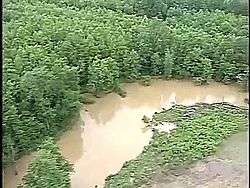Muscatatuck River

The Muscatatuck River[1] is a 53.7-mile-long (86.4 km)[2] bifurcate river in south-central Indiana, United States. It is a major tributary of the East Fork of the White River, and drains 1,000 square miles (2,600 km2). In one area it serves as the southern boundary of the main unit of the Muscatatuck National Wildlife Refuge. It also goes across the Crosley Fish and Wildlife Area and by Muscatatuck County Park.[3][4]
The path of the Muscatatuck was formed by valley beds created during an ice age. It is believed that the first people arrived and lived by the Muscatatuck around 8000 BC, maintaining permanent structures between 1000 BC to 1000 AD. The first documented whites arrived in 1818, although it is possible that squatters lived in the area before Indiana's 1816 statehood.[5][6]
In the early 20th century, the name of the river was "Muscackituck". It is believed that the original white name was "Muscakituck", written in 1812 by a man named Tipton. Some believe the name comes from the Munsee words for "swamp" and "river".[7]
The 88.5-mile-long (142.4 km)[2] Vernon Fork of the Muscatatuck[8] is a longer branch of the river than the main stem, or southern branch, of the Muscatatuck. The Vernon Fork provides the city of North Vernon with its drinking water, and flows for 59 miles (95 km) of its length in Jennings County.[9] The town of Vernon is nearly surrounded by the Vernon Fork, with only a small neck of dry land that leads to North Vernon.[10]
Before 1830, the Muscatatuck River was navigable, with local settlers being able to ship pork down the river to eventually reach New Orleans. However, around 1830, the river became no longer navigable, as dirt fill accumulated along the river bed. However, some groups "float" along stretches of the river.[3][10] The Cavanaugh Bridge crosses the river southwest of Brownstown, Driftwood Township, Jackson County, Indiana.[11]:5 It was listed on the National Register of Historic Places in 2007.[12]
Noted Hoosier artist T. C. Steele particularly loved using the Muscatatuck River in his paintings.[13]
See also
References
- ↑ U.S. Geological Survey Geographic Names Information System: Muscatatuck River
- 1 2 U.S. Geological Survey. National Hydrography Dataset high-resolution flowline data. The National Map, accessed May 19, 2011
- 1 2 Muscatatuck River in Indiana. Maps of river and Maps to public access points and liveries
- ↑ Jennings County, Indiana, 1816-1999 (Jennings County Historical Society (J.C.H.S.), 2005) pg. 114
- ↑ Annual Report of the Geological Survey of Indiana, Made During the Year 1874 (Indiana Geological Survey, 1875) p.57
- ↑ McClure, Phil. Our Memories of Home: A Link to the Muscatatuck (AuthorHouse, 2007) pg.xx
- ↑ McCafferty, Michael. Native American Place Names of Indiana (University of Illinois Press, 2008). p.154-155
- ↑ U.S. Geological Survey Geographic Names Information System: Vernon Fork Muscatatuck River
- ↑ Friends of the Muscatatuck
- 1 2 J.C.H.S., pg.105
- ↑ "Indiana State Historic Architectural and Archaeological Research Database (SHAARD)" (Searchable database). Department of Natural Resources, Division of Historic Preservation and Archaeology. Retrieved 2016-04-01. Note: This includes Joanne Raetz Stuttgen (April 2007). "National Register of Historic Places Inventory Nomination Form: Cavanaugh Bridge" (PDF). Retrieved 2016-04-01. and Accompanying photographs.
- ↑ National Park Service (2010-07-09). "National Register Information System". National Register of Historic Places. National Park Service.
- ↑ J.C.H.S., pg.26